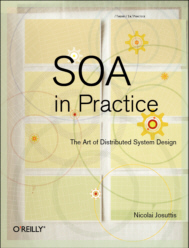
Now available:
SOA in Practice
The Art of Distributed System Design
O'Reilly
IISBN-10: 0-596-52955-4
ISBN-13: 978-0-596-52955-0
| SOA in Practice: Table of Contents |
 |
|
|
|
Now available:SOA in Practice O'Reilly |
The first half of the book covers the basics (spiced with some practical experience), while the second half of the book discusses specific aspects of introducing and running SOA.
The following table lists all chapters. In addition, it gives some examples
about experiences from and hints for the practice, which might be new or surprising
for you.
| Chapter | Contents | Example for Relevancy to Practice | |
| Preface | |||
| 1 | Motivation | This chapter explores why you want to use SOA in the context of large distributed systems, explores how SOA emerged, tells the tale of the Magic Bus, and gives a brief overview of SOA. | Understand characteristis of large distributed system landscapes. |
| 2 | SOA | This chapter examines and consolidates the different definitions of SOA and its major properties. |
Understand how and why SOA definitions differ. |
| 3 | Services |
This chapter examines and consolidates definitions of the many services involved in SOA. |
Understand the difference between business-driven and technical-driven
business interfaces. |
| 4 | Loose Coupling |
This chapter introduces and discusses loose coupling, a key concept in
SOA and building large distributed systems generally. |
Get to know 11 forms of loose coupling. |
| 5 | Enterprise Service Bus | This chapter takes a look at the enterprise service bus (ESB), the infrastructure foundation for high interoperability in a SOA landscape. |
Compare different approaches to implement an ESB. |
| 6 | Service Classification | This chapter shows how to categorize services so that you can deal with
different service classes, service layers, and stages of SOA expansion. |
Understand the major categorization of services and different terminology
used for it. Understand the difference of business processes running in services and business processes running in backends. |
| 7 | Business Process Management | This chapter introduces business process management (BPM) as an approach for identifying services as part of business processes. It includes orchestration, Business Process Execution Language (BPEL), portfolio management, and choreography. |
Learn how to come from a business requirement to a service-based solution. |
| 8 | SOA and the Organization | This chapter discusses the impacts SOA strategies have on organizations
and companies. |
Learn why SOA can be a problem detector for the culture of organizations. |
| 9 | SOA in Context | This chapter explores how SOA fits with other architectures and approaches,
and how to deal with the various levels of processing at different parts of a business. |
Compare different architectural views of soa based system landscapes. |
| 10 | Message Exchange Patterns | This chapter introduces and discusses message exchange patterns (MEPs). MEPs define the sequence of messages in a service call or operation. One of these patterns will lead to events and event-driven architectures (EDA). |
Understand why two one-way messages are different from a request/response
message exchange pattern. |
| 11 | Service Lifecycle | This chapter follows the lifecycle of services, from needs identification
to implementation, and from running to withdrawing. |
Learn why having a policy not to have more than three versions of a service in operation in practice does not work. |
| 12 | Versioning | This chapter discusses the thorny question of version services, including versioning of associated data types. |
Understand the different forms of versioning. |
| 13 | SOA and Performance | This chapter discusses how performance, especially running time, affects
the design and reusability of services. |
Learn how performance has an impact on the granularity and reuse of services. |
| 14 | SOA and Security | This chapter presents security issues in SOA implementations and how to address them. | Learn about the "XML bomb" and why SSL (HTTPS) is not enough to deal with security. |
| 15 | Technical Details | This chapter explores some key details of SOA, including statefulness,
idempotency, testing and debugging, and fundamental data types. |
Learn how to implement idempotency to deal with nonreliable protocols. |
| 16 | Web Services | This chapter examines Web Services and their position as a de facto standard for SOA infrastructure. It presents the most important Web Services standards, and what their application means in practice. |
Learn why Web Services do not necessarily provide interoperability and
how to deal with this problem. |
| 17 | Service Management | This chapter discusses using repositories and registries to manage services. |
Learn about the difference of repositories and registries and why you don't need repositories from the beginning. |
| 18 | Model-Driven Service Development | This chapter describes the consequences of specifying services as models,
and generating code from those models. |
Understand the role of meta models and why XSLT is not appropriate in complex code generations. |
| 19 | Establishing SOA and SOA Governance | This chapter examines how SOA might or should be established in an organization,
and explores its governance moving forward. |
Learn why central service teams should make themselves unnecessary. |
| 20 | Epilogue | This conclusion finally discusses some major questions about SOA, including
whether it is really new, where its use is appropriate, and whether it increases
or reduces complexity. |
Get the ultimate answer to the question whether SOA is something new. |
| References | see soa-references.html | ||
| Glossary | see soa-glossary.html | ||
| Index |